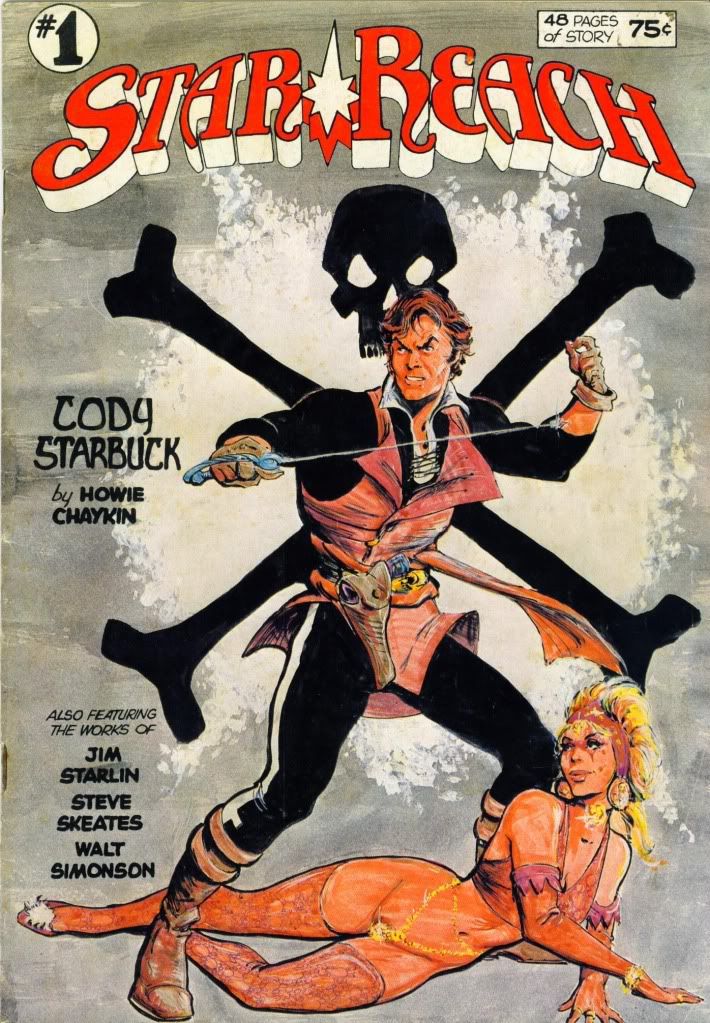Epic Illustrated #1 (Spring 1980) Story & Art by James Starlin
Synopsis: Za is a bestial Tyjorian on an inhospitable world around Alpha Centauri. He's not like his fellows, and as his knowledge and self-awareness grows, he's becoming less like them all the time.
Tyjorians are the only life on their planet and so are cannibals. Only their rapid rate of reproduction keeps them from killing off their species. Their brutal lifestyle never forced them to develop civilization or even empathy.
Za was born different. The meat of his own kind sickened him, so he had to subsist on his world's strange blue crystals. After his mother died, Za never joined a band. He lived alone, making him a target for groups of other Tyjorians:
He had the strength of 10 Tyjorian males thanks to his diet of blue crystals. None could harm him, but he was still alone.
One day, he met a female and that changed. He felt an emotion unlike the fleeting mating instincts of his species. He brought her meat and protected her. Then one day he couldn't. She was killed while he was away. Feeling a sadness his kind was never made to feel, he climbed high into the mountains intending to end his life. Instead, he met someon--and found it's purpose.
Aknaton apologized, for he was the cause of Za's pain. He had bestowed knowledge and given the ability to understand speech. Aknaton needs a monster with a mind and a soul. There is a darkness spreading across the stars, and it cannot be defeated, only destroyed.
So the two jump on the back of a giant, insect-like creature and head out to their next destination: Earth.
Tyjorians are the only life on their planet and so are cannibals. Only their rapid rate of reproduction keeps them from killing off their species. Their brutal lifestyle never forced them to develop civilization or even empathy.
Za was born different. The meat of his own kind sickened him, so he had to subsist on his world's strange blue crystals. After his mother died, Za never joined a band. He lived alone, making him a target for groups of other Tyjorians:
He had the strength of 10 Tyjorian males thanks to his diet of blue crystals. None could harm him, but he was still alone.
One day, he met a female and that changed. He felt an emotion unlike the fleeting mating instincts of his species. He brought her meat and protected her. Then one day he couldn't. She was killed while he was away. Feeling a sadness his kind was never made to feel, he climbed high into the mountains intending to end his life. Instead, he met someon--and found it's purpose.
Aknaton apologized, for he was the cause of Za's pain. He had bestowed knowledge and given the ability to understand speech. Aknaton needs a monster with a mind and a soul. There is a darkness spreading across the stars, and it cannot be defeated, only destroyed.
So the two jump on the back of a giant, insect-like creature and head out to their next destination: Earth.
Things to Notice:
The hints dropped in Chapter I about Aknaton's activities when he was away from Aknaton begin to pay off. The next few chapters will follow the same pattern of character introduction
The improbability of Tyjoria's ecology just serves to accentuate its a symbolic nature. Tyjoria is the hostile universe in microcosm; it's literally dog eat dog. Za isn't just an everyman, he's all humankind, self-aware and adrift in a savage world, wondering why he suffers and why the world is the way it is. Only love makes it bearable for him, but then he loses that, too. Just when he's about to end it all, God shows up.
Za is a bit like Job, but at least the god Za encounters apologizes (somewhat perfunctorily) for the sufferinghe has caused and gives a reason for it. Still, Aknaton doesn't explain a lot; Za is forced to take things on faith. Given the world he was living in, it's really no wonder Za grabs hold to what Aknaton offers, however vague it may be.
When he does, we see the emergence of another sort of narrative, though one influenced by Biblical ones: the fantasy quest.
- Za looks a bit like a later Starlin creation, Skeeve.
The hints dropped in Chapter I about Aknaton's activities when he was away from Aknaton begin to pay off. The next few chapters will follow the same pattern of character introduction
The improbability of Tyjoria's ecology just serves to accentuate its a symbolic nature. Tyjoria is the hostile universe in microcosm; it's literally dog eat dog. Za isn't just an everyman, he's all humankind, self-aware and adrift in a savage world, wondering why he suffers and why the world is the way it is. Only love makes it bearable for him, but then he loses that, too. Just when he's about to end it all, God shows up.
Za is a bit like Job, but at least the god Za encounters apologizes (somewhat perfunctorily) for the sufferinghe has caused and gives a reason for it. Still, Aknaton doesn't explain a lot; Za is forced to take things on faith. Given the world he was living in, it's really no wonder Za grabs hold to what Aknaton offers, however vague it may be.
When he does, we see the emergence of another sort of narrative, though one influenced by Biblical ones: the fantasy quest.






















